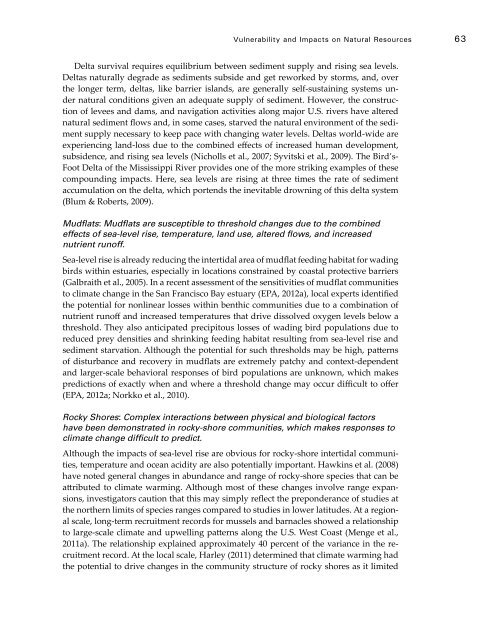Coastal Impacts, Adaptation, and Vulnerabilities - Climate ...
Coastal Impacts, Adaptation, and Vulnerabilities - Climate ...
Coastal Impacts, Adaptation, and Vulnerabilities - Climate ...
Create successful ePaper yourself
Turn your PDF publications into a flip-book with our unique Google optimized e-Paper software.
Vulnerability <strong>and</strong> <strong>Impacts</strong> on Natural Resources 63Delta survival requires equilibrium between sediment supply <strong>and</strong> rising sea levels.Deltas naturally degrade as sediments subside <strong>and</strong> get reworked by storms, <strong>and</strong>, overthe longer term, deltas, like barrier isl<strong>and</strong>s, are generally self-sustaining systems undernatural conditions given an adequate supply of sediment. However, the constructionof levees <strong>and</strong> dams, <strong>and</strong> navigation activities along major U.S. rivers have alterednatural sediment flows <strong>and</strong>, in some cases, starved the natural environment of the sedimentsupply necessary to keep pace with changing water levels. Deltas world-wide areexperiencing l<strong>and</strong>-loss due to the combined effects of increased human development,subsidence, <strong>and</strong> rising sea levels (Nicholls et al., 2007; Syvitski et al., 2009). The Bird’s-Foot Delta of the Mississippi River provides one of the more striking examples of thesecompounding impacts. Here, sea levels are rising at three times the rate of sedimentaccumulation on the delta, which portends the inevitable drowning of this delta system(Blum & Roberts, 2009).Mudflats: Mudflats are susceptible to threshold changes due to the combinedeffects of sea-level rise, temperature, l<strong>and</strong> use, altered flows, <strong>and</strong> increasednutrient runoff.Sea-level rise is already reducing the intertidal area of mudflat feeding habitat for wadingbirds within estuaries, especially in locations constrained by coastal protective barriers(Galbraith et al., 2005). In a recent assessment of the sensitivities of mudflat communitiesto climate change in the San Francisco Bay estuary (EPA, 2012a), local experts identifiedthe potential for nonlinear losses within benthic communities due to a combination ofnutrient runoff <strong>and</strong> increased temperatures that drive dissolved oxygen levels below athreshold. They also anticipated precipitous losses of wading bird populations due toreduced prey densities <strong>and</strong> shrinking feeding habitat resulting from sea-level rise <strong>and</strong>sediment starvation. Although the potential for such thresholds may be high, patternsof disturbance <strong>and</strong> recovery in mudflats are extremely patchy <strong>and</strong> context-dependent<strong>and</strong> larger-scale behavioral responses of bird populations are unknown, which makespredictions of exactly when <strong>and</strong> where a threshold change may occur difficult to offer(EPA, 2012a; Norkko et al., 2010).Rocky Shores: Complex interactions between physical <strong>and</strong> biological factorshave been demonstrated in rocky-shore communities, which makes responses toclimate change difficult to predict.Although the impacts of sea-level rise are obvious for rocky-shore intertidal communities,temperature <strong>and</strong> ocean acidity are also potentially important. Hawkins et al. (2008)have noted general changes in abundance <strong>and</strong> range of rocky-shore species that can beattributed to climate warming. Although most of these changes involve range expansions,investigators caution that this may simply reflect the preponderance of studies atthe northern limits of species ranges compared to studies in lower latitudes. At a regionalscale, long-term recruitment records for mussels <strong>and</strong> barnacles showed a relationshipto large-scale climate <strong>and</strong> upwelling patterns along the U.S. West Coast (Menge et al.,2011a). The relationship explained approximately 40 percent of the variance in the recruitmentrecord. At the local scale, Harley (2011) determined that climate warming hadthe potential to drive changes in the community structure of rocky shores as it limited
















